Coyote Hunting
Predatorial Series - #1 "Basic Behavior"
By Greg Ballard
 It has been a lot of years since I shot my first coyote. I remember my Dad and I sitting in the darkness on our first coyote hunting trip, shotgun in hand, and listening to a cassette player we had rigged up with a small external speaker. The tape we had in it was a yellow hammer woodpecker in distress. I could hear the coyote’s approach through the leaves as it made its way off the hillside and down to the clearing where we sat in a brush pile in ambush. When it sounded like the coyote was close enough Dad turned on his light that had a red lens on it and at the end of the beam of light were two big coyote eyes glowing and the bead of the shotgun moved to the shoulder of the coyote and I squeezed the trigger. The coyote wheeled and started to run, but he was already dead. It only took a little bit of time before the coyote realized it and crashed to the ground. I was hooked on coyote hunting for life. Fast forward 30 some odd years and many hundreds of coyotes later and I still get just as excited as I did when hunting that night.
It has been a lot of years since I shot my first coyote. I remember my Dad and I sitting in the darkness on our first coyote hunting trip, shotgun in hand, and listening to a cassette player we had rigged up with a small external speaker. The tape we had in it was a yellow hammer woodpecker in distress. I could hear the coyote’s approach through the leaves as it made its way off the hillside and down to the clearing where we sat in a brush pile in ambush. When it sounded like the coyote was close enough Dad turned on his light that had a red lens on it and at the end of the beam of light were two big coyote eyes glowing and the bead of the shotgun moved to the shoulder of the coyote and I squeezed the trigger. The coyote wheeled and started to run, but he was already dead. It only took a little bit of time before the coyote realized it and crashed to the ground. I was hooked on coyote hunting for life. Fast forward 30 some odd years and many hundreds of coyotes later and I still get just as excited as I did when hunting that night.
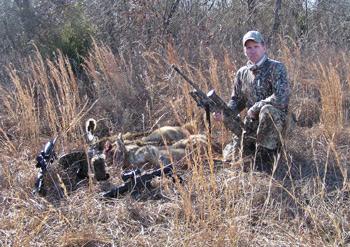
The results of a morning coyote hunt in Oklahoma in 2007. We called in 9 coyotes this morning and were able to take 5 of them
Coyote hunting has become quite popular in recent years and with good reason. Coyotes make for very exciting hunting that takes a good amount of knowledge and skill to become consistently successful. You are hunting the hunter and beating him at his own game. This adds a whole new level to your coyote hunting as you get to be an interactive part of the equation and not be a passive part. To be able to beat the coyote on a regular basis is no small feat as the coyote has a lot of skills and abilities of his own. I believe that the best way to get to this level of consistency in coyote hunting is to first take some time and learn a bit about the quarry. By learning more about the coyote and his behavior and life cycles then we will be able to take the advantages and behavior of the coyote and turn them against him when hunting.
The coyote, Canis Latrans, is found just about everywhere in the United States. If you don’t already have coyotes in your area then it is just a matter of time before you will. The coyote is a very hardy animal and can easily survive in nearly any climate and condition found in the country. A full grown coyote will have a body weight that can range from 20 pounds up to over 50 pounds depending on the location the coyote is found. The body fur of the coyote is generally a grayish and the legs are a reddish brown coloration. The coyote tail is fully furred and black tipped. They will carry their tail lower than their back which differentiates the coyotes from a dog. Their underbelly and fur under their neck is generally whitish in color. They have a very elongated nose and large pointed ears that gives the coyote a quite distinctive look. Their feet are more elongated than that of a dog and the front feet of the coyote are generally larger than their rear feet. This helps you to distinguish the tracks of a coyote from those of a dog when you come across them during your scouting.
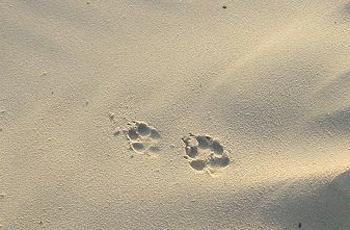
The coyote track can be distinguished from a domestic dog as the tracks will be more elongated in appearance and the coyote's front paw will be larger than the rear paw
Coyotes will form small family groups, but you will mostly see them running by themselves or as part of a hunting pair. They are a territorial animal and their territory will generally be 6 - 8 square miles, but males will sometimes have a territory that extends up to 40 square miles in size. They protect this territory most fervently during the times of the year when they are rearing their pups. The breeding season for the coyotes will start in late January and last until mid March with most of the breeding taking place during February. The female will excavate a den into a hillside or berm or take up a rocky shelter to have her pups which are born about 63 days after she is bred. The number of pups born is regulated by the amount of available food in the region. The better the food sources the more pups will be born. This can be attributed to a better overall health of the female. During this time of gestation and rearing the male may be the only member of the pair doing the hunting and will bring food back to the female for her and her pups to feed upon. The pups will stay with the female until later in the year and will most times disperse out to seek their own territories and possibly seek out their own mates by December of the year they are born in. This is a large part of the reason for the rapid expansion of the coyote throughout the United States.
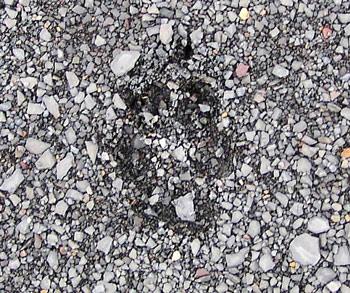
The tracks of a coyote on this shale road indicate that the coyote was a recent visitor to this area, as the tracks are fresh.
The coyote can be located after dark by listening for their individual and group howling. The coyote has a very large vocalization upwards of a dozen sounds or so and the coyote hunter should become familiar with as many of those communications as they can. You can also scout along dirt roads, trails and creek beds in the area looking for the telltale tracks and scat of the coyote. The coyote’s track will look very much like that of a dog, but the track will have more of a pointy elongated shape than that of a dog. The front paw tracks are slightly larger than the rear paw tracks and a domestic dog will generally have more symmetrical tracks. The coyote track is about 2 ½” in length and it is common to have the front and rear track overlapping. You will many times find coyote scat on dirt roads as the coyotes will often travel these roads on their patrols through their territories and they will mark their territory by depositing this sign along with urination and ground scratching along their travel routes. The coyote scat will most always contain large amounts of hair and often small bones as they eat their prey hair and all.
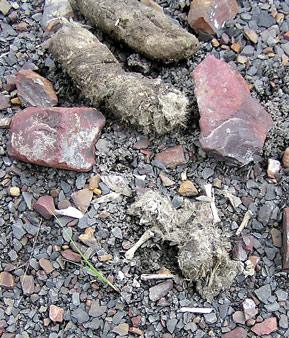
You will be able to identify the scat of the coyote by the presence of hair and bones within the scat itself.
The coyote has some extremely good survival tools at their disposal. They have very good eyesight, they can hear extremely well and their sense of smell has been determined by some to be more than 10,000 times better than a human. They are known to be highly intelligent, although I think a large part of this apparent intelligence should be more attributed to their extreme senses and instinct than to any sort of reasoning ability. The successful hunter will have to overcome all of the coyote’s senses. This makes hunting coyotes a very challenging task to say the least, but it is quite doable on a very consistent basis when one understands the behaviors of the coyote and uses those mannerisms to full advantage. It is these behaviors that help to keep the population of coyotes expanding and by knowing this behavior you can design your hunting strategies around them.
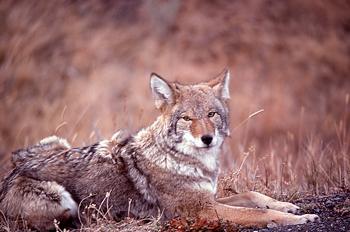
The coyote is a master of adaptability and can survive and flourish in most any type of terrain in the United States.
I will be writing a series of articles, I call them Predatorials, for LongRangeHunting.com covering many different aspects of hunting the coyote. We will cover the set-ups, various equipment needs and specialized tactics that will make you a more successful coyote hunter. Later in this series, I will take you along with me on some actual coyote hunts and show you exactly how and why I did what I did and the results that I get. We will take them at up in your face range to way, way out there using a variety of tools and tactics. It is going to be fun.
Join the discussion of this article with the author HERE at the Article Discussion Forum.Greg Ballard resides in Arkansas where he is a computer programmer building automated stock market trading systems and stock market trading software tools. He is an avid outdoorsman who has been hunting since he was big enough to walk and has been doing so primarily as a bowhunter for the past 25 years. He is on the Pro Field Staff for PSE Archery and the Pro Staff for Grim Reaper Broadheads. Greg hunts a wide variety of game, but one of his most favorite things to hunt is predators. He has recently formed and is President of the Arkansas Predator Hunters Association.
Predatorial Series - #1 "Basic Behavior"
By Greg Ballard


The results of a morning coyote hunt in Oklahoma in 2007. We called in 9 coyotes this morning and were able to take 5 of them
Coyote hunting has become quite popular in recent years and with good reason. Coyotes make for very exciting hunting that takes a good amount of knowledge and skill to become consistently successful. You are hunting the hunter and beating him at his own game. This adds a whole new level to your coyote hunting as you get to be an interactive part of the equation and not be a passive part. To be able to beat the coyote on a regular basis is no small feat as the coyote has a lot of skills and abilities of his own. I believe that the best way to get to this level of consistency in coyote hunting is to first take some time and learn a bit about the quarry. By learning more about the coyote and his behavior and life cycles then we will be able to take the advantages and behavior of the coyote and turn them against him when hunting.
The coyote, Canis Latrans, is found just about everywhere in the United States. If you don’t already have coyotes in your area then it is just a matter of time before you will. The coyote is a very hardy animal and can easily survive in nearly any climate and condition found in the country. A full grown coyote will have a body weight that can range from 20 pounds up to over 50 pounds depending on the location the coyote is found. The body fur of the coyote is generally a grayish and the legs are a reddish brown coloration. The coyote tail is fully furred and black tipped. They will carry their tail lower than their back which differentiates the coyotes from a dog. Their underbelly and fur under their neck is generally whitish in color. They have a very elongated nose and large pointed ears that gives the coyote a quite distinctive look. Their feet are more elongated than that of a dog and the front feet of the coyote are generally larger than their rear feet. This helps you to distinguish the tracks of a coyote from those of a dog when you come across them during your scouting.

The coyote track can be distinguished from a domestic dog as the tracks will be more elongated in appearance and the coyote's front paw will be larger than the rear paw
Coyotes will form small family groups, but you will mostly see them running by themselves or as part of a hunting pair. They are a territorial animal and their territory will generally be 6 - 8 square miles, but males will sometimes have a territory that extends up to 40 square miles in size. They protect this territory most fervently during the times of the year when they are rearing their pups. The breeding season for the coyotes will start in late January and last until mid March with most of the breeding taking place during February. The female will excavate a den into a hillside or berm or take up a rocky shelter to have her pups which are born about 63 days after she is bred. The number of pups born is regulated by the amount of available food in the region. The better the food sources the more pups will be born. This can be attributed to a better overall health of the female. During this time of gestation and rearing the male may be the only member of the pair doing the hunting and will bring food back to the female for her and her pups to feed upon. The pups will stay with the female until later in the year and will most times disperse out to seek their own territories and possibly seek out their own mates by December of the year they are born in. This is a large part of the reason for the rapid expansion of the coyote throughout the United States.

The tracks of a coyote on this shale road indicate that the coyote was a recent visitor to this area, as the tracks are fresh.
The coyote can be located after dark by listening for their individual and group howling. The coyote has a very large vocalization upwards of a dozen sounds or so and the coyote hunter should become familiar with as many of those communications as they can. You can also scout along dirt roads, trails and creek beds in the area looking for the telltale tracks and scat of the coyote. The coyote’s track will look very much like that of a dog, but the track will have more of a pointy elongated shape than that of a dog. The front paw tracks are slightly larger than the rear paw tracks and a domestic dog will generally have more symmetrical tracks. The coyote track is about 2 ½” in length and it is common to have the front and rear track overlapping. You will many times find coyote scat on dirt roads as the coyotes will often travel these roads on their patrols through their territories and they will mark their territory by depositing this sign along with urination and ground scratching along their travel routes. The coyote scat will most always contain large amounts of hair and often small bones as they eat their prey hair and all.

You will be able to identify the scat of the coyote by the presence of hair and bones within the scat itself.
The coyote has some extremely good survival tools at their disposal. They have very good eyesight, they can hear extremely well and their sense of smell has been determined by some to be more than 10,000 times better than a human. They are known to be highly intelligent, although I think a large part of this apparent intelligence should be more attributed to their extreme senses and instinct than to any sort of reasoning ability. The successful hunter will have to overcome all of the coyote’s senses. This makes hunting coyotes a very challenging task to say the least, but it is quite doable on a very consistent basis when one understands the behaviors of the coyote and uses those mannerisms to full advantage. It is these behaviors that help to keep the population of coyotes expanding and by knowing this behavior you can design your hunting strategies around them.

The coyote is a master of adaptability and can survive and flourish in most any type of terrain in the United States.
I will be writing a series of articles, I call them Predatorials, for LongRangeHunting.com covering many different aspects of hunting the coyote. We will cover the set-ups, various equipment needs and specialized tactics that will make you a more successful coyote hunter. Later in this series, I will take you along with me on some actual coyote hunts and show you exactly how and why I did what I did and the results that I get. We will take them at up in your face range to way, way out there using a variety of tools and tactics. It is going to be fun.
Join the discussion of this article with the author HERE at the Article Discussion Forum.Greg Ballard resides in Arkansas where he is a computer programmer building automated stock market trading systems and stock market trading software tools. He is an avid outdoorsman who has been hunting since he was big enough to walk and has been doing so primarily as a bowhunter for the past 25 years. He is on the Pro Field Staff for PSE Archery and the Pro Staff for Grim Reaper Broadheads. Greg hunts a wide variety of game, but one of his most favorite things to hunt is predators. He has recently formed and is President of the Arkansas Predator Hunters Association.

